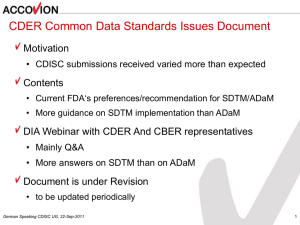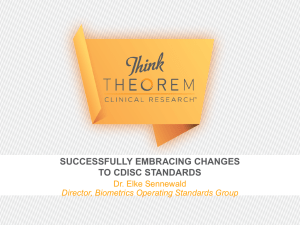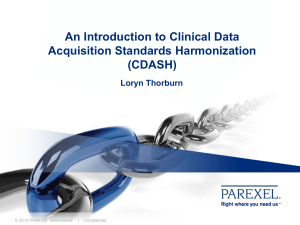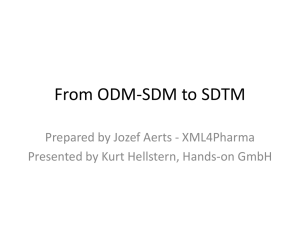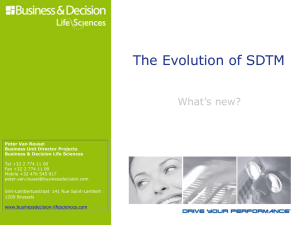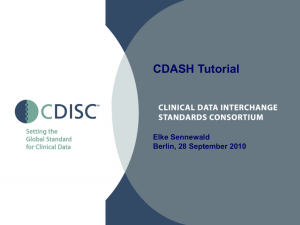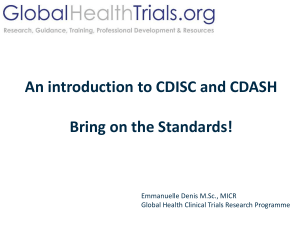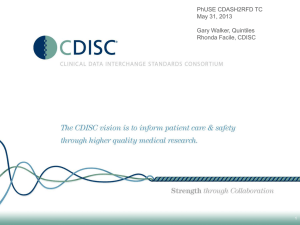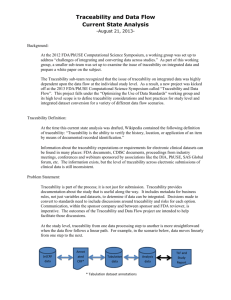The Importance of CDASH Presentation
advertisement
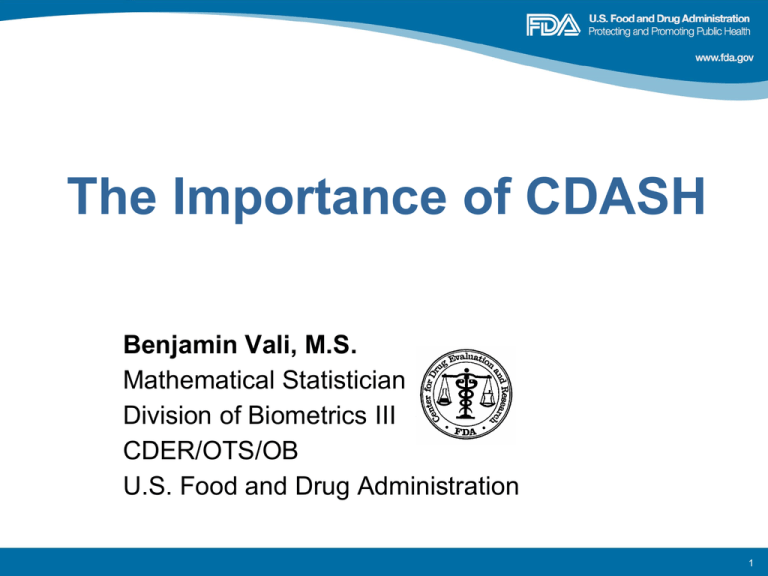
The Importance of CDASH Benjamin Vali, M.S. Mathematical Statistician Division of Biometrics III CDER/OTS/OB U.S. Food and Drug Administration 1 FDA Disclaimer This presentation reflects the views of the authors and should not be construed to represent FDA’s views or policies. Outline • What do we do? – NDA/BLA Statistical Review of Efficacy • What do we need? – All Regulatory Reviewers at FDA/CDER • What do we get? – Current Approaches • CDASH – Focusing on The Best What do we do? Statistical Review of Efficacy for NDA/BLA Regulation Citation 21 CFR 314.126 ....Reports of adequate and well-controlled investigations provide the primary basis for determining whether there is "substantial evidence" to support the claims of effectiveness for new drugs. What do we do? Statistical Review of Efficacy for NDA/BLA • These “adequate and well-controlled investigations” pertain to the “Pivotal/Confirmatory” trials (i.e. Phase 3 trials) in a clinical development program • Consequently all aspects of these protocols and corresponding Statistical Analysis Plans (SAPs) need to be pre-specified – including how the clinical data are captured What do we do? Statistical Review of Efficacy for NDA/BLA • Key Analysis Questions to ask during Marketing Application Review: – Are the key results correct? • Programmatically validate all major results during the filing review - IMPORTANT! What do we do? Statistical Review of Efficacy for NDA/BLA • Programmatically validate all major results during the filing review • Reviewer needs – – – – – Protocol SAP Clinical Study Report (CSR) Annotated case report form (aCRF) Tabulation/clinical datasets with corresponding metadata/data definition file (SDTM, define.xml) – Analysis datasets with corresponding metadata/data definition file (ADaM, define.xml) – Reviewers’ guide (e.g., SDRG & ADRG) What do we do? Statistical Review of Efficacy for NDA/BLA • Programmatically validate all major results during the filing review – Two-step process • Independent quality validation of Analysis Dataset Variables – Primary and Key Secondary Endpoints – Additional key subject-level analysis variables (e.g. analysis set flags) • Independent quality validation of Analysis Results – Inferential and/or Descriptive What do we do? Statistical Review of Efficacy for NDA/BLA • Key Analysis Questions to ask during Marketing Application Review: – Are the results consistent? • • • • Similar findings from each clinical study Not sensitive to different approaches to analysis Similar across study subgroups Supported by results from secondary endpoints (which are generally related to primary endpoints) • Conduct further analyses with support and insight from Medical Officer What do we need? All Regulatory Reviewers at FDA/CDER • Metadata • Traceability • Data Standards Why Push for Traceability? • Full transparency for each data point throughout (end-to-end) clinical data lifecycle (from the source “to my computer”) • Need to make sure that the data were captured and analyzed in a way that is consistent with what was pre-specified in the protocol and SAP! The Clinical Data Lifecycle Source Documents Case Report Form (CRF) Clinical Database Analysis Database Tables, Listings, and Figures (TLFs) Clinical Study Report (CSR) Product Labeling Promotional Materials Why Push for Data Standards? Overall Improved Efficiency Analyzing Data • Consistent data structure • Consistent nomenclature • Analysis-ready • Standardize not only the data – Metadata – Representation of the relationship between data elements – Communication • SDRG and ADRG Traceability vs. Data Standards • MY Regulatory Reviewer Perspective – Traceability is key – Traceability may be even more important than Data Standards (To Me) And I know it is important to you… • Inherent in this principle is a need for traceability to allow an understanding of where an analysis value (whether an analysis result or an analysis variable) came from, i.e., the data’s lineage or relationship between an analysis value and its predecessor(s). CDISC ADaM v2.1…. 15 Traceability vs. Data Standards • What we often see submitted by Applicants – In the creation of standard data for submissions, traceability is (at times), compromised by post-data-capture mapping Current Approaches Approach #1 (Historical/Legacy) … Legacy CRF Clinical Database Analysis Database TLFs … Approach #2 (Starting Out …) SDTM … Legacy CRF Clinical Database Analysis Database TLFs … Approach #3 (Getting Better …) SDTM ADaM … Legacy CRF Clinical Database Analysis Database TLFs … Approach #4 (Better and Better …) SDTM ADaM … Legacy CRF Clinical Database Analysis Database TLFs … Approach #5 (Getting There …) … Legacy CRF Clinical Database SDTM ADaM TLFs … Approach #6 (The Best) … CDASH CRF SDTM ADaM TLFs … CDASH • CDASH - Clinical Data Acquisition Standards Harmonization • Best facilitates mapping to SDTM and creation of high quality CRF pages • Closest to 1-to-1 mapping in terms of structure, content and format – Pages for 16 out of 25 major SDTM domains are covered – Best Practices for creating other domain pages CDASH • Gets it right the first time – Done at data capture stage! – Eliminates the need for more downstream work • Streamlines everything on the Production and Regulatory Review sides • Standards development instituted as early as possible within the clinical data lifecycle – CDASH is the best example of how effective this can be CDASH • The original premise, per DIA Meeting in January 2006, was for efficiency • Motivated by ACRO and FDA – Critical Path • Current Version 1.1 – January 18, 2011 – We’ve come a long way since previous versions/previous era • Version 2.0 release imminent • Will begin development of therapeutic area specific CRFs As We Move Forward… • Don’t map for the sake of mapping (i.e., from legacy datasets to SDTM and ADaM) – Approaches #2, #3 and #4 – Unnecessary cost (time and money) to applicants • Includes time and money wasted for responding to subsequent Information Requests during the review cycle! • Strive for Approach #6 – no mapping required! As We Move Forward… • The principle behind this approach is key – More so than the CDASH standard itself • Implementation is everything! – More so than the content standards in general themselves – Must adhere to CDISC foundational principles 28 As We Move Forward… • Right now we are living during a “transitional” period (i.e., from legacy to standardized data), hence you need to do what you need to do – Don’t pull the e-brake while going at 150 mph • This doesn’t have to happen today – Just eventually… 29 Thank you for your attention!
